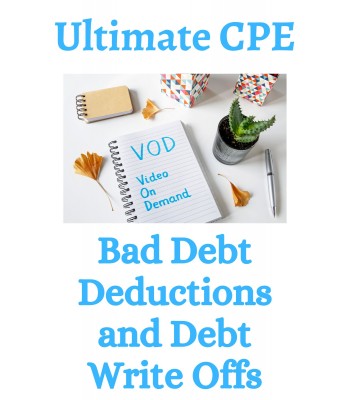UltimateCPE, Inc. is registered with the National Association of State Boards of Accountancy (NASBA) as a sponsor of continuing professional education on the National Registry of CPE Sponsors. State boards of accountancy have final authority on the acceptance of individual courses for CPE credit. Complaints regarding registered sponsors may be submitted to the National Registry of CPE Sponsors through its website: NASBAregistry.org.
Author: Jennifer Kowal
| CPE Credit: | 2 hours for CPAs 2 hours Federal Tax Related for EAs and OTRPs 2 hours Federal Tax Law for CTEC |
With the looming economic recession, understanding the rules for claiming tax deductions for bad debts is more important than ever. In an economic downturn, the possibility increases that taxpayers won’t be fully paid for trade receivables and other debt instruments.
In order to reduce the financial hit from bad debts, it is important to understand the tax provisions applicable to partially worthless, wholly worthless, secured and non-business bad debts. What is considered a bad debt to a business person may not necessarily represent a bad debt for tax purposes.
Publication Date: April 2023
Designed For
null
Topics Covered
- Definition of Debt and Basic Distinctions from Equity
- Debt Workouts Resulting in Bad Debt Deduction
- Rules for Deducting Business Bad Debts v. Nonbusiness Bad Debts
- Wholly worthless debts v. Partially Worthless Debts
- Documentation of Worthlessness
- Difference in Rules for Cash and Accrual Method Taxpayers
Learning Objectives
- Describe a bona fide debt deductible as bad debt for tax purposes
- Identify tax consequences of related party bad debts
- Recognize how to differentiate between business bad debts and nonbusiness bad debts
- Describe factors that prove worthlessness of debt
- Recognize how to evaluate the best timing for claiming a bad debt
Level
Intermediate
Instructional Method
Self-Study
NASBA Field of Study
Taxes (2 hours)
Program Prerequisites
Basic understanding of debt deductions and debt write-offs.
Advance Preparation
None
Additional Course Details
- Filed of Study: Taxation
- Publisher: Wolters Kluwer
- Course Level: Basic
- Pre-Requisites: None
Write a review
Your Name:Your Review: Note: HTML is not translated!
Rating: Bad Good
Enter the code in the box below:


